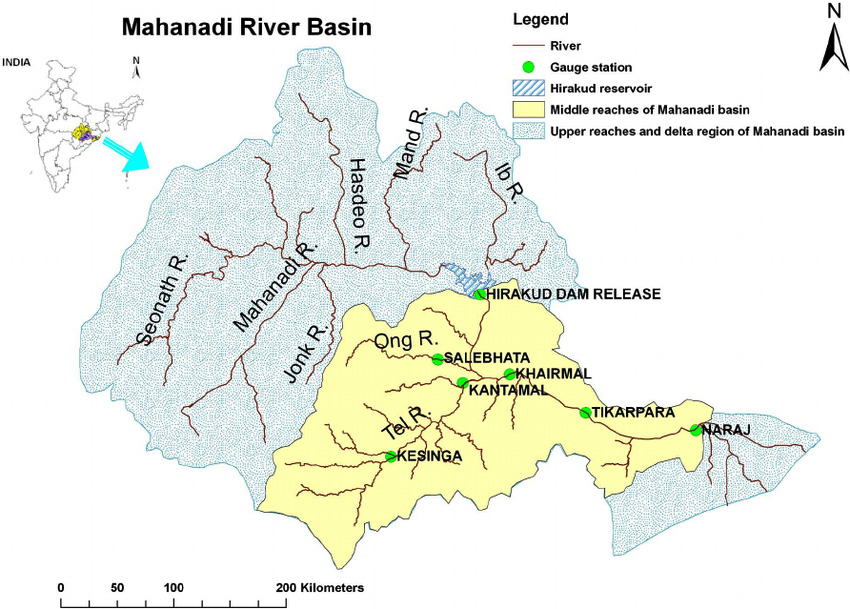Governance
NHRC Issues Notice in Hirakud Displacement Case
- 02 Mar 2021
- 7 min read
Why in News
The National Human Rights Commission (NHRC) issued notices to the Chief Secretaries of Odisha and Chhattisgarh over the action taken to alleviate the sufferings of people displaced by the construction of the Hirakud dam over the Mahanadi river about six decades ago.
- About 111 villages were submerged due to the construction of Hirakud Dam and around 22,000 families were affected, while about 19,000 families were displaced.
Key Points
- Hirakud Dam Project:
- Establishment:
- It is a multipurpose scheme conceived by Er. M. Visveswaraya in 1937, after recurrence of devastating floods in Mahanadi river. Its first hydro power was commissioned in 1956.
- Location:
- The dam is built across river Mahanadi at about 15 km upstream of Sambalpur town in the state of Odisha.
- Objectives:
- Irrigation: The project provides 1,55,635 hectares of Kharif and 1,08,385 ha of Rabi irrigation in the districts of Sambalpur, Bargarh, Bolangir and Subarnapur.
- The water released through the power house irrigates further 4,36,000 ha of regions in Mahanadi Delta.
- Power Generation: The installed capacity for power generation is 347.5 MW through its two power houses at Burla, at the right bank and Chiplima, at 22 km downstream of the dam.
- Flood Control: The project provides flood protection to Mahanadi basin including 9500 sq. km of delta area in districts of Cuttack and Puri.
- Irrigation: The project provides 1,55,635 hectares of Kharif and 1,08,385 ha of Rabi irrigation in the districts of Sambalpur, Bargarh, Bolangir and Subarnapur.
- Establishment:
- Mahanadi River:

- About:
- The Mahanadi River system is the third largest of peninsular India after Godavari and Krishna, and the largest river of Odisha state.
- The catchment area of the river extends to Chhattisgarh, Madhya Pradesh, Odisha, Jharkhand and Maharashtra.
- Its basin is bounded by the Central India hills on the north, by the Eastern Ghats on the south and east and by the Maikala range on the west.
- Source:
- It rises from a place near Sihawa in Bastar hills in the state of Chhattisgarh to the south of Amarkantak.
- Major Tributaries of the Mahanadi river
- Seonath River
- Hasdeo River
- Mand River
- Ib River
- Jonking River
- Tel River
- Mahanadi River Dispute: The Central Government constituted Mahanadi Water Disputes Tribunal in 2018.
- About:
National Human Rights Commission
- About: It is a statutory body established on 12th October, 1993 by the Protection of Human Rights Act (PHRA), 1993. It was amended by the Protection of Human Rights (Amendment) Act, 2006 and Human Rights (Amendment) Act, 2019.
- The PHRA Act also provides for the creation of a State Human Rights Commission at the state level.
- International Obligation: The United Nations Paris Principles provided the international benchmarks against which national human rights institutions (NHRIs) can be accredited by the Global Alliance of National Human Rights Institutions (GANHRI). Paris Principles (1993) were implemented in India by passing PHRA Act, 1993.
- Watchdog of Human Rights: The NHRC is an embodiment of India’s concern for the promotion and protection of human rights.
- Section 2(1)(d) of the PHRA defines Human Rights as the rights relating to life, liberty, equality and dignity of the individual guaranteed by the Constitution or embodied in the International Covenants and enforceable by courts in India.
- Composition: The commission is a multi-member body consisting of a chairman and four members. A person who has been the Chief Justice of India or a judge of the Supreme Court is a chairman.
- Appointment: The chairman and members are appointed by the President on the recommendations of a six-member committee consisting of the Prime Minister as its head, the Speaker of the Lok Sabha, the Deputy Chairman of the Rajya Sabha, leaders of the Opposition in both the Houses of Parliament and the Union Home Minister.
- Tenure: The chairman and members hold office for a term of three years or until they attain the age of 70 years, whichever is earlier.
- The President can remove the chairman or any member from the office under some circumstances.
- Functions:
- Powers of a Civil Court:
- It has all the powers of a civil court and its proceedings have a judicial character.
- It is empowered to utilise the services of any officer or investigation agency of the Central government or any state government for the purpose of investigating complaints of human rights violation.
- It can look into a matter within one year of its occurrence, i.e the Commission is not empowered to inquire into any matter after the expiry of one year from the date on which the act constituting violation of human rights is alleged to have been committed.
- Power to Recommend:
- The functions of the commission are mainly recommendatory in nature. It has no power to punish the violators of human rights, nor to award any relief including monetary relief to the victim.
- Its recommendations are not binding on the concerned government or authority. But, it should be informed about the action taken on its recommendations within one month.
- It has limited role, powers and jurisdiction with respect to the violation of human rights by the members of the armed forces.
- It is not empowered to act when human rights violations through private parties take place.
- Powers of a Civil Court:





